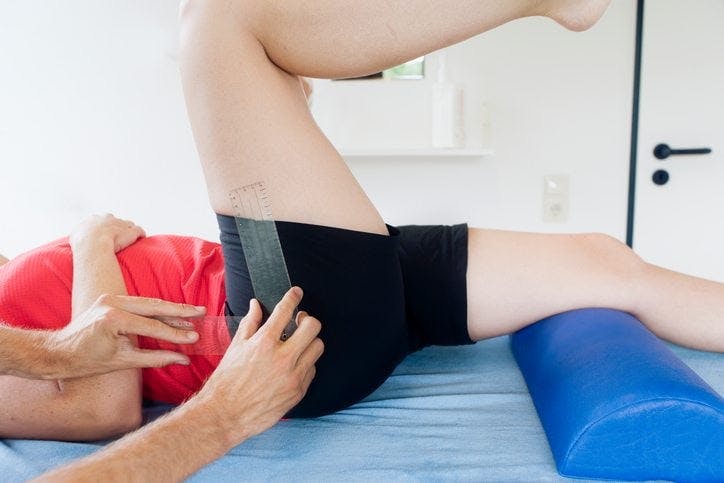A big part of recovery after a hip replacement involves rehabilitating the pelvic joint to regain full range of motion in the hip. This can be accomplished through exercise, which is recommended for 20 or 30 minutes multiple times per. These exercises are great during recovery.
Ankle Exercises
The ankle and other muscles in the lower leg should be exercised regularly to help keep them strong and to improve the circulation of blood in the legs. Here are a couple examples:
- Ankle pumps: Lying on your back with your legs extended, flex your foot outward, pushing your heel away from your body. Hold this pose, with your toes pointed upward and toward your body, for five seconds. Next, point the toes outward and away from the body, moving your heel back toward your calf. Hold this for five seconds. You can perform this exercise immediately after surgery until you have recovered fully.
- Ankle rotations: Three or four times a day, move your ankle inward in the direction of your other foot. Next, move it outwards and away from the other foot. Repeat this five times per session.
Squeezes
It’s also important to work out muscles that are involved with supporting and controlling the hips like your quadriceps and gluteus muscles:
- Quad squeezes: The quads, or quadriceps, are muscles in the front of the thigh that help support and control the hip. Lie on your back, extend your legs and contract the quad muscles in your thigh. Keep your leg straight as if you’re pressing the back of your knee into the ground. Hold this for five seconds at a time.
- Glute squeezes: The gluteus muscles, found in the back of the hip, also provide support. To exercise them, lie on your back and squeeze your buttocks in, holding for five seconds.
Hip Exercises
- Hip abductions: This exercise is meant to lift your leg away from the body to work the hip muscles. While lying on your back, extend the legs and slide the affected leg to the side away from the body with toes pointed upward. Move the leg back to the center—never move it beyond the center, as this can put you at risk of dislocating the injured hip. Always keep the unaffected leg fully straight and extended.
- Standing hip abductions: Over time, you’ll gain enough strength to be able to do hip abductions standing up. Take care to make sure the hip, knee and foot are all pointing straight forward while you lift your leg out toward the side, then lower it slowly until your foot is back on the floor. Use the back of a chair or counter to brace yourself. Once you’re ready, your physical therapist may show you how to use elastic bands to add additional resistance.
- Hip extensions: While standing, lift the leg slowly backward while keeping your back straight. Hold this for two or three seconds, then release. Repeat this 10 times per day over three or four sessions.
Knee Exercises
- Knee extensions: While sitting in a chair, raise your foot and extend your knee until your leg is fully straight. Hold for five seconds and then slowly release.
- Knee bends: Keeping your heel on a bed for support, bend your knee and slide your heel toward your buttocks. Be sure not to let your knee roll inward. Repeat this exercise 10 times, broken up into a few sessions throughout the day.
- Knee raises: While standing, lift the leg on the affected side of your hip toward your chest. Don’t go above your waist. Hold this for two or three seconds, then lower and repeat 10 times.
Heel Slides
To help strengthen the quads and glutes, lie on your back and flex the new hip and corresponding knee. Lift your knee off the bed as you slide your foot along it, keeping the unaffected leg straight the entire time. Hold this for 10 seconds.
Although these are standard exercises after a hip replacement, your surgeon or physical therapist may recommend different exercises. Consult them before implementing a new exercise into your routine.
Dr. Carlson tends to be conservative with surgical treatment, and much of his training is in minimally-invasive procedures, such as arthroscopy. He believes everyone deserves a trial of a more conservative treatment before moving to more invasive treatments such as surgery. Dr. Carlson tries to spend time with patients to better understand their goals and work together to come up with a treatment plan based on those goals and their distinct medical history.
Sources:
“Hip Replacement Surgery Rehabilitation Exercises.” Arthritis Health. https://www.arthritis-health.com/surgery/hip-surgery/hip-replacement-surgery-rehabilitation-exercises
“9 Exercises For a Speedy Recovery Post Hip Replacement Surgery.” Texas Health Spine & Orthopedic Center. https://www.texashealthspineortho.org/blog/9-exercises-for-a-speedy-recovery-post-hip-replacement-surgery/





